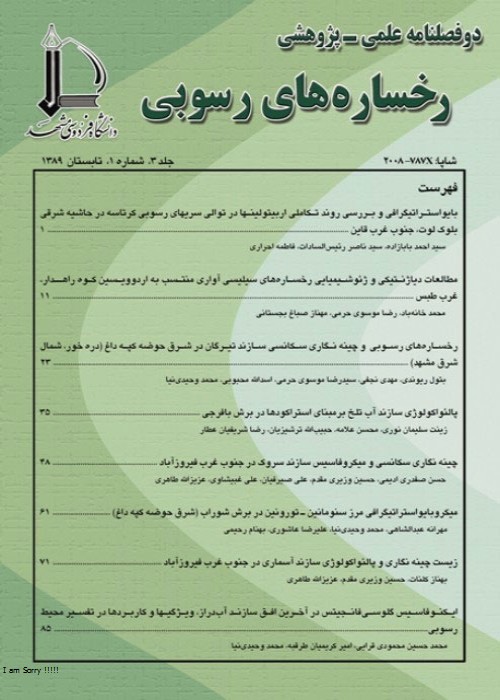Microfacies, Sedimentary Environment and diagenetic processes of Surmeh Formation (Arab Member) in Salman Oil field, Persian Gulf, Iran
Author(s):
Article Type:
Research/Original Article (دارای رتبه معتبر)
Abstract:
Introduction
The Surmeh Formation, with the age of Late Jurassic, is one of the geographically widespread formations in the Zagros and Persian Gulf (Zigler, 2001), The major part of the Salman Oil Field, about two thirds, lies within Iranian waters, while one third is located in territorial waters of Abu Dhabi (Figure 1). As it is one of the most important oil reservoirs in the region, the Surmeh Formation contains gigantic oil reserves. The Surmeh Formation in the Salman Oil Field comprises mainly limestone and dolomite. It is equivalent to the Arab Formation of Saudi Arabia and other Arab countries (Al-Shahran & Narin, 2003). Surmeh Formation in Salman Oil Field is one of the most important oil tanks in the southeast of the Persian Gulf. The Salman oil field has different oil and gas reservoirs from different periods of Permian to Jurassic (James & Wynd, 1965). The main objective of this research is to identify sedimentary conditions and reservoir characteristics of Surmeh Formation.
Materials and Methods
223 thin sections (with a maximum distance of 30 cm) were prepared and most of them stained with Alizarin Red-S solution and ferricyanide potassium using the Dickson method (1965) in order to recognize calcite from dolomite. The carbonate microfacies were classified according to Dunham (1962) classification and a sedimentary model was proposed using Flugel (2010) scheme. The textures of dolomites were described following Sibley and Gregg (1987). Data gained from aforementioned sources were gathered in order to build and define facies, a depositional model, different diagenetic stages and reservoir quality. The present study is based on laboratory studies of microscopic thin sectionsmade from core samples. Results and
conclusion
This semi-circular shape of the Salman Oil Field structure reflects its origin as a salt dome.The ten identified microfacies include massive, nodular and laminated anhydrite with chicken-wire fabric, dolomudstone, mudstone with crystals and anhydrite nodules, wavy to laminated dolostromatolite boundstone, bioclast dolopackstone/dolowackestone, peloid-bioclastic dolopackstone/ dolowackestone, peloid-bioclastic dolograinstone, ooid-peloid dolograinstone, ooid dolograinstone, and bioclastic intraclast dolograinstone implying that the Surmeh Formation was deposited in four different environments from sabkha to marine shoal in a homoclinal carbonate ramp setting. The marine and meteoric diagenetic settings were susceptible to produce a variety of features from different types and phases of dolomitization, anhydritization, via cements from early marine to late diagentic cements to micritization, neomorphism, compaction and dissolution. Between all processes affected the Surmeh reservoir, dolomitization, in most cases, enhanced reservoir quality whereas anhydritization reduced reservoir quality.Porosity variations along the Upper and Lower Arab units in Salman field is directly related to the amount of dolomitization. It also should be stated that, moderate to good reservoir quality is seen in facies belong to moderate to high energy zones of leeward to seaward shoal environments, whereas shallower facies of the inner ramp has the lowest amount of porosity and permeability. In these environments, pores have been filled with the secondary cements. The most important pore types are intergranular, intragranular, vuggy and moldic which are mostly seen in grain-dominated facies. Four types of dolomite in mud-dominated and two kinds of dolomite in grain-dominated textures have been recognized. Mud-dominated dolomites include dolomicrite, dolomicrosparite, dolosparite and scattered dolomites in a limestone matrix. Grain-dominated dolomites are known as fabric retentive and fabric destructive. Sabkha and seepage-reflux models are proposed for the formation of these dolomites. According to these models, it should be mentioned that the type 1 dolomites formed in sabkha environment, while types 2, 3 and 4 are formed under the influence of recrystallization of dolomicrites in a shallow burial environment. In addition, dolomitization in grain-dominated textures occurred from seepage-reflux processes in shoals adjacent to the limited and hypersaline lagoons. Acknowledgment
The authors are greatly acknowleged the Department of Geology, Islamic Azad University, North Tehran Branch and IOOC for providing all the data and logestic support for this study. We are also grateful to anonymous reviewers for their critical review and suggestions that improved our manuscript significantly. Keywords: Sedimentary environment; Diagenesis; Microfacies; Surmeh Formation; Salman Oil Field. References
Alsharhan, A.S., & Narin, A.E.M., 2003. Sedimentary basins and petroleum geology of the Middle East. Elsevier Science, Netherland, 843 p.
Dickson, J.A.D., 1965. A modified staining technique for carbonate in thin section. Nature, 205: 587.
Dunham, R.J., 1962. Classification of carbonate rocks according to depositional texture. American Association of Petroleum Geologists Memoir, 1: 108-121.
Flugel, E., 2010. Microfacies of Carbonate Rocks: Analysis, Interpretation and Application. Springer Verlag, New York, 996 p.
James, G.A., & Wynd J.G., 1965. Stratigraphic nomenclature of Iranian oil consortium agreement area. American Association of Petroleum Geologists Bulletin, 49 (12): 2182-2245.
Sibley, D.F., & Gregg, J.M., 1987. Classification of dolomite rock textures. Journal of Sedimentary Petrology, 57 (5): 967-975.
Zeigler, M.A., 2001. Late Permian to Holocene paleofacies evolution of the Arabian plate and its hydrocarbon occurrences. GeoArabia, 6(3): 445-504
Keywords:
Language:
Persian
Published:
Sedimentray Facies, Volume:9 Issue: 1, 2016
Pages:
35 to 56
https://magiran.com/p1892749


